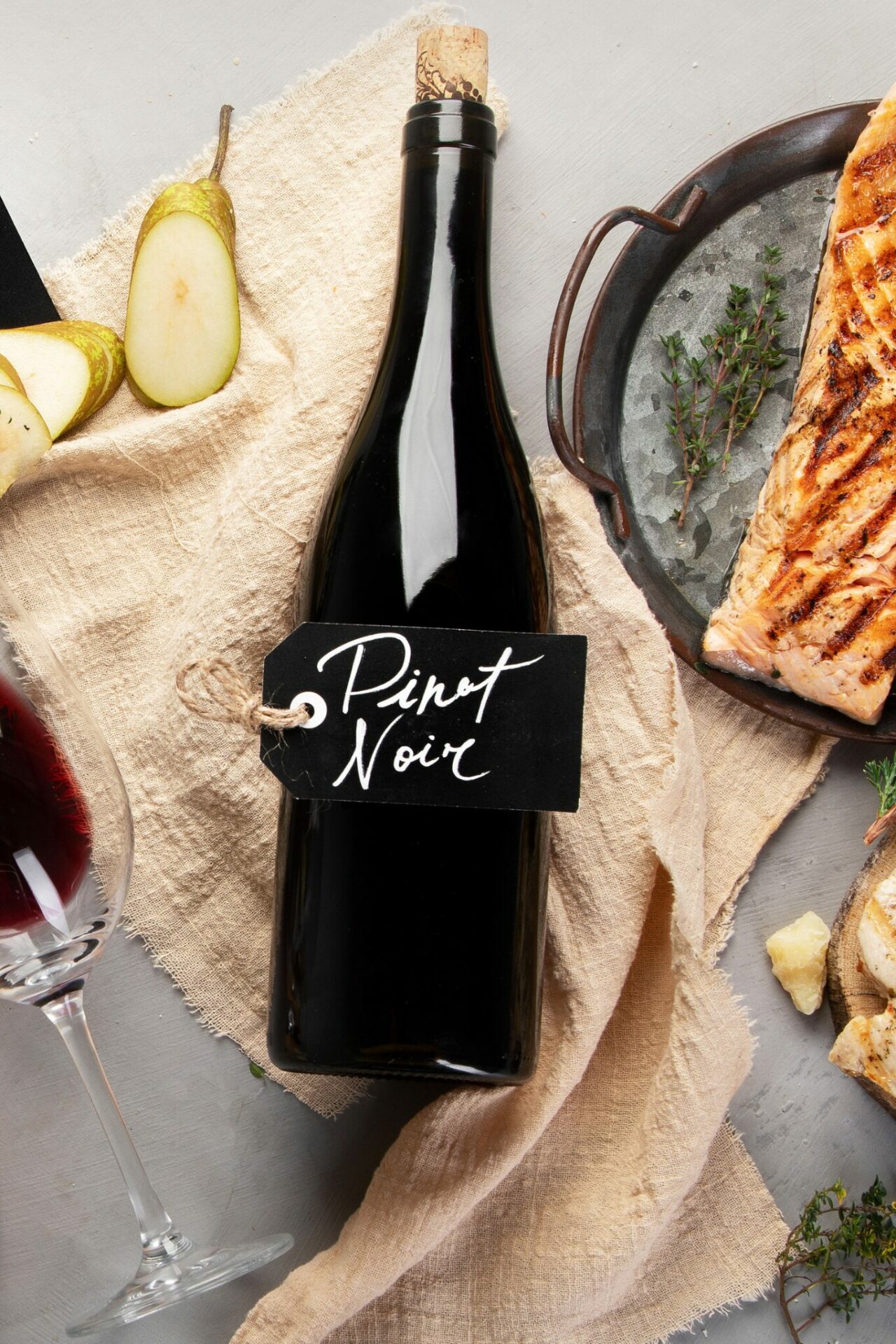
Pinot Noir is one of the great grapes of the world. It’s incredibly expressive of the terroir, has the ability to age, and can be made in a wide range of styles, allowing winemakers to really play and articulate their abilities. It’s difficult to grow, but the rewards are more than worth it.
This wine is grown all over the world, but a few regions are truly known for it. These include especially Burgundy, France, Oregon, and Sonoma.
Personally, Pinot Noir is both one of my favorite varietals and also consistently responsible for my lowest-rated wine. When it’s done well, it’s incredible. When done badly, it’s undeniably noticeable.
Looking for bottle to drink? Check out our list of Best Pinot Noir wine to buy for every budget!
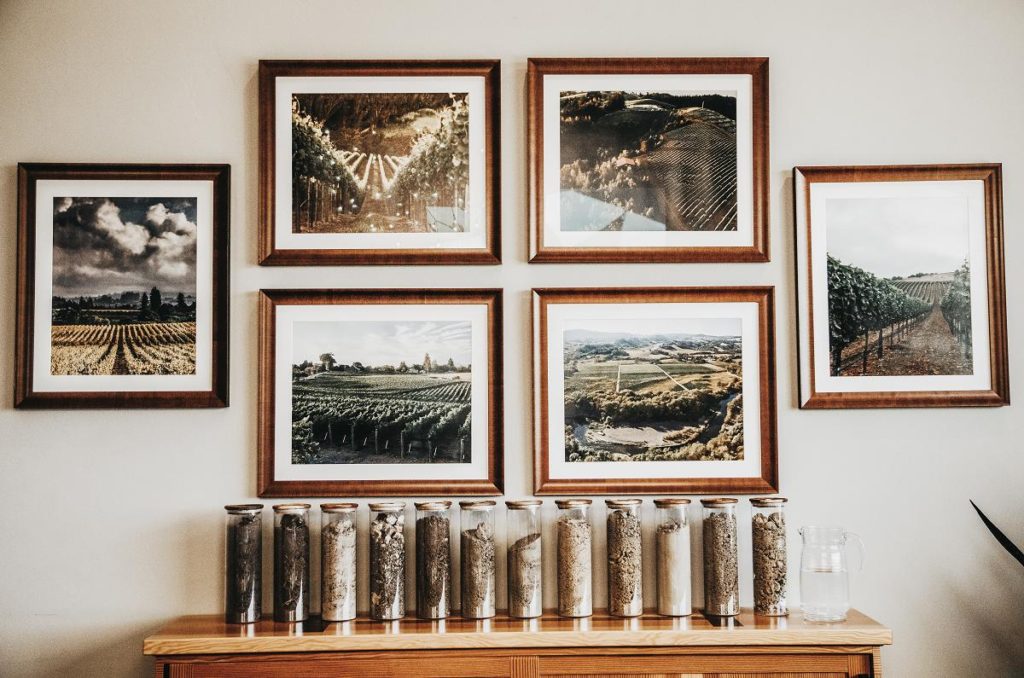
What is Pinot Noir?
Pinot Noir is a type of dry red wine made from the Pinot Noir grape. It’s famous for its light to medium body, delicate flavors, and complex aromas. This grape is quite tricky to grow because it’s sensitive to climate and soil conditions, but when done right, it can produce amazing wine.
Imagine taking a bite of a ripe cherry or raspberry – that’s the kind of fruity flavor you might find in a glass of this wine. For example, the 2022 Double L Pinot Noir from Morgan Winery offers lively aromas of black cherry and raspberry, with a palate enriched by notes of blackberry, ripe red fruits, and delicate floral undertones.
Some people also say it has hints of earthiness, like the smell of mushrooms or damp leaves, which adds to its charm.
Pinot Noir can vary a lot depending on where it’s grown. For example, a Pinot Noir from California might taste different from one made in France’s Burgundy region. It’s fun to explore these differences and discover which ones you like best!
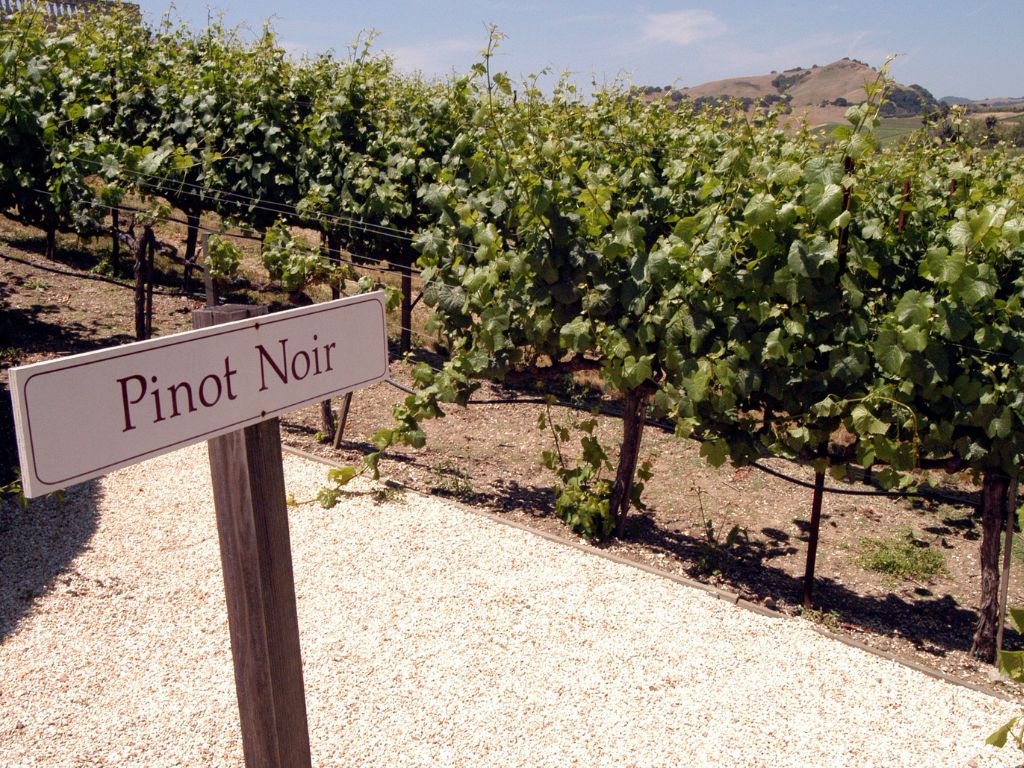
Notable Pinot Noir Regions
Pinot Noir is the 10th most planted grape in the world and is grown in a range of wine regions.
Burgundy: The King of Pinot Noir
Here the wine is typically herbaceous and light in style, with earthy aromas like forest floor and a nose full of mushrooms and wet leaves. There are floral aromas, like violets and roses, with some mild fruit smells that tend towards cherry. Often you’ll also find notes of black tea. It is often revered as the pinnacle of this wine variety.
Oregon Pinot Noir
Pinot Noir also finds a home in Oregon, where it accounts for over 60% of the wine grape harvest.
Due to the microclimates in the state’s growing areas and the winemaker’s tendency to try new things, these wines tend to have a wide range in style. I’ve had everything from dark, muscly Pinot Noir to a more fruit-forward ripe Pinot, to a refined Burgundian-esque version… and everything in between!
It’s not uncommon for winemakers throughout Oregon and in the well-known Willamette Valley region to create single-vineyard wines that truly express the unique microclimates and soil types that are present in small areas.
California Pinot Noir
California is known for its delicious wines, and there are a few regions that stand out for producing top-notch bottles of this varietal.
One famous area is the Russian River Valley, where cool fog from the nearby Pacific Ocean creates perfect conditions for growing Pinot Noir grapes. These wines often have a silky texture with flavors of ripe red cherries and a hint of spice.
Another notable region is the Santa Lucia Highlands, known for its sunny days and cool nights, which give the grapes a chance to develop rich flavors while retaining refreshing acidity.
In California’s Central Coast, the Santa Rita Hills AVA is gaining attention for its elegant and vibrant Pinots, showcasing flavors of cherry, plum, and earthy notes.
Chilean Pinot Noir
Chilean wine is gaining recognition for its high quality and great value. Regions like Casablanca Valley and Leyda Valley, with their cool climate and ocean influence, are particularly well-suited for growing this varietal.
Chilean Pinot often showcases vibrant red fruit flavors, such as cherry and raspberry, along with subtle earthy notes, making it a delightful and approachable choice for both casual sipping and pairing with a variety of dishes.
German Pinot Noir
While Germany is better known for its Riesling wines, there are some regions producing noteworthy Pinot Noir, locally known as Spätburgunder.
The Baden region, located in the southwest of Germany, is particularly renowned for its Spätburgunder wines, which often display a delicate balance of fruitiness and earthiness.
These German wines tend to be lighter in body compared to those from warmer climates, with flavors of red berries, subtle spice, and a refreshing acidity.

What does Pinot Noir Taste Like?
Pinot Noir wines typically taste like a delicious blend of fruity and earthy flavors. Picture biting into a ripe cherry or raspberry – that’s the kind of fruity goodness you might find in a glass of this wine.
Alongside that, you might notice hints of earthiness, like the smell of mushrooms or damp leaves, which adds depth and complexity to the wine.
Some Pinots also have subtle spice notes, like a dash of cinnamon or clove, adding another layer to its flavor profile.
Overall, Pinot Noir is known for its light to medium body, delicate flavors, and smooth texture, making it a versatile and enjoyable wine for many occasions.
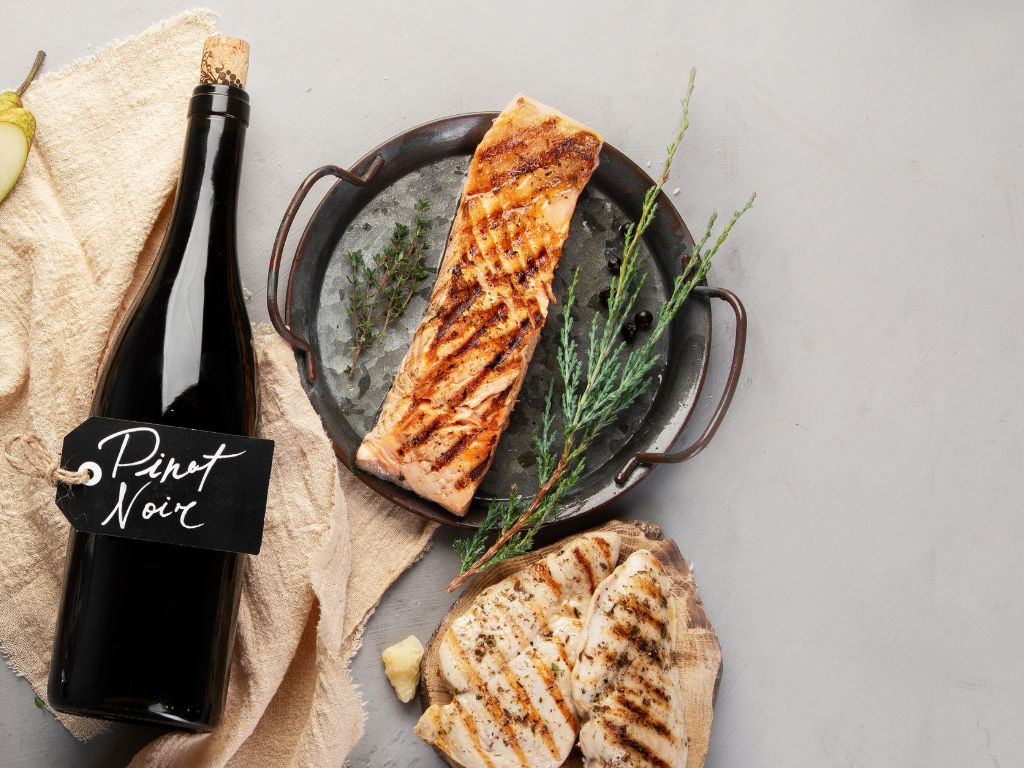
Pinot Noir Food Pairings
Pairing Pinot Noir with food is a delightful experience because its versatile flavors complement a wide range of dishes. Here are some simple guidelines to get you started:
Lighter meats: A glass of this wine pairs wonderfully with lighter meats like chicken, turkey, pork, and duck. Its acidity and fruitiness balance the richness of these meats without overpowering them.
Salmon and other fatty fish: The delicate flavors complement the richness of salmon and other fatty fish dishes. Its acidity helps cut through the oiliness, creating a harmonious pairing.
Earthier dishes: Since Pinot often has earthy notes, it pairs beautifully with dishes featuring mushrooms, truffles, or earthy herbs like thyme and rosemary. Think mushroom risotto, truffle pasta, or roasted root vegetables.
Soft cheeses: The wine’s medium body and acidity make it a fantastic match for soft and creamy cheeses like brie, camembert, or triple cream cheeses. The wine’s fruitiness contrasts nicely with the richness of the cheese.
Charcuterie: Pinot Noir is a great choice for charcuterie boards, as it complements a variety of cured meats, pâtés, and savory snacks. The wine’s acidity helps cleanse the palate between bites.
Remember, these are just guidelines, and the most important thing is to experiment and find pairings that you enjoy!

Sparkling Wines
Pinot Noir plays a crucial role in the world of sparkling wine, particularly in producing Blanc de Noirs, a style made exclusively from red grapes, including Pinot Noir and Pinot Meunier.
Its vibrant red fruit flavors, such as black cherry and red berries, lend depth and complexity to sparkling wines, while its subtle earthy notes add an intriguing dimension to the palate. Pinot Noir often contributes to the structure and body of sparkling wines, providing a solid backbone for the bubbles to dance upon.
Whether in a traditional méthode champenoise or other sparkling wine styles, Pinot’s versatility shines, offering delightful expressions in every sip.
When is Pinot Noir Day?
Pinot Noir Day is celebrated on August 18th, so get your bottles ready!
To be up to date on all the Wine Holidays, check out the Annual Wine Holiday Calendar!
FAQs:
Is Pinot Noir Dry?
Yes, most styles of Pinot Noir are dry. Depending on the producer and the region, however, it is likely to find a bottle bursting with fruit flavors that make it seem “sweet” on the palate. Read more: Is Pinot Noir Sweet?
Is Pinot Noir Red or White?
Pinot Noir is a red wine… in fact, Pinot Noir means “black pine”, referring to the tight clusters of black-colored berries that hang off its vines. The thin skins and low levels of phenolic compounds lend the grapes to produce mostly lightly colored, medium-bodied and low-tannin wines, dry wines.
How to pronounce Pinot Noir?
Pinot Noir is pronounced “pee-noh nwahr.” The “Pinot” is pronounced with a short “i” sound like in “pit,” followed by “noh” with a silent “t,” and “nwahr” with a soft “w” sound and a slightly rolled “r” at the end.
Should Pinot Noir be chilled?
Yes – but only slightly! Pinot Noir is typically served slightly chilled. The ideal temperature for serving Pinot Noir is around 55-60°F (13-16°C).
Chilling the wine slightly enhances its refreshing acidity and helps to bring out its fruity flavors, while still allowing its delicate aromas to shine. However, be cautious not to overchill it, as serving it too cold can mute its flavors and aromas.
The best way to get it the right temperature is to chill the wine in the refrigerator for just about 15-20 minutes before serving (not longer!)
Read more: How to Chill Wine Fast
What does Pinot Noir mean?
Pinot Noir means “black pine”, referring to the tight clusters of black-colored berries that hang off its vines.
Recommended Pinot Noir...
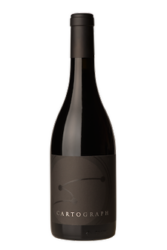
Pinot Noir is the primary focus at Cartograph, and they make a beautiful lineup that focuses on balance, nuance and complexity, rather than power and intensity. Their Estate Pinot Noir in particular is intensely dark and ruby in color, bursting with chalky mushrooms, baking cocoa, and blackberry aromas. On the palate, these aromas are balanced by rose petal, mint and a touch of olive tapenade.
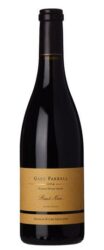
Gary Farrell produces an entire line of distinct Pinot Noirs from single vineyards. Depending on whether you’re looking for fruity or earthy — or anywhere in between — there’s a different Pinot Noir for you. My personal favorite in their lineup is the Fort Ross Vineyard Pinot Noir; with a gorgeous coastal expression of fruit, the wine is dark, earthy and savory, exuding aromas of tobacco, Oolong tea leaves, cassis, blackberry and violet petals.
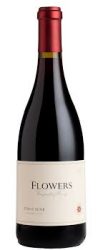
Flowers Vineyard & Winery Pinot Noir
Flowers believes in crafting wines with a sense of place and are dedicated to being people with a sense of purpose. For nearly 30 years they’ve been growing Pinot Noir and Chardonnay on the rugged Sonoma Coast, leading to them being called “wilderness winemakers”. They make minimal intervention wines – a mix of biodynamic and organic farming in the vineyard for healthy soil. Their entire lineup of Pinot Noirs are distinctly delicious.
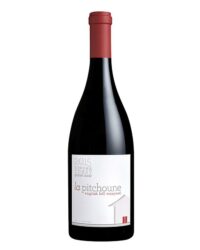
La Pitchoune English Hill Vineyard Pinot Noir
Inspired by a small family property in the South of France, La Pitchoune means “the little one.” The name speaks to small production, small lots, and the idea that small size is their greatest asset. La Pitchoune believes in crafting old-world style Pinot Noirs that are food-friendly and ageable. Their Sonoma Coast English Hill Vineyard Pinot Noir is particularly outstanding. Its bright and lively red fruit flavors are highlighted by a smoked citrus component that mingle with juniper, sumac, tobacco and cedar.

Boedecker Cellars Athena & Stewart Pinot Noirs
Crafted by a husband-wife-duo in downtown Portland from Willamette Valley grapes, Boedecker Cellars is an absolutely outstanding example of an urban winery done right. Their Pinot Noirs are absolutely cult-worthy, and perhaps most fun of all, each year the duo makes two distinct Pinot Noirs in their own individual style preference. More modern for Athena, more traditional for Stewart. I would happily sip on either (or both!) any day.

Big Basin Vineyards Lester Family Pinot Noir
Big Basin Vineyards was founded in 1998 on an historic site in the Santa Cruz Mountains next to Big Basin Redwoods State Park. This particular Pinot Noir is from the Lester Family Vineyard nearby — the Corralitos foothills of the Santa Cruz Mountains where it resides are just a few miles from the deep waters and abundant fog of Monterey Bay. In the wine, you’ll find high-toned aromatics with hints of rose petals, baking spices, and pomegranates lingering on the nose. On the palate, the aromatics echo the nose with a backbone of sappy red fruit.
